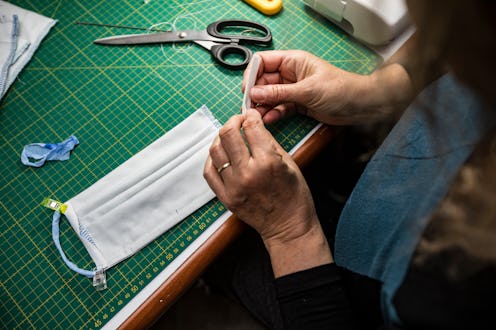
One item that’s become synonymous with the coronavirus pandemic is the face mask. But with N95 and medical-grade masks going for a premium these days due to the needs of health care professionals, they’re increasingly difficult to find.
If you haven’t been able to buy a mask, you might be thinking about making one for yourself in an effort to help stop the spread of COVID-19. With White House officials poised to encourage people to wear cloth face masks in public as an alternative to medical-grade masks, there’s no time like the present to learn how to make one at home.
Why are cloth masks being recommended now?
The fact that a person infected with COVID-19 can be asymptomatic appears to be what’s influencing the shift in guidance from government officials. Surgical and N95 masks are not recommended for this purpose since health care providers on the frontline need those the most. Instead, DIY masks are encouraged.
What do I need to make a DIY mask?
First and foremost, you’ll need some type of cloth.
“In general, the thicker and more tightly woven the material is, the more protective it likely will be,” Dr. Nate Favini, medical lead at Forward, tells Bustle. “We also have some reason to think that vacuum filters may be more effective in filtering viral particles, and might be a good middle layer between an inner and outer layer of fabric.”
While there are endless mask-making tutorials available online, this step-by-step guide from The New York Times is pretty straightforward, even if you’re an amateur sewer. To make a suitable cloth face mask that will come in handy for essential tasks like grocery shopping, all you need are a few simple household items:
- Sewing tools, i.e. a needle and thread or sewing machine
- Scissors
- Pins/clips
- 20” x 20” (or larger) fabric (tea towel, dish towel, antimicrobial pillowcase)
- 4 strips for ties (cotton, shoe lace)
Alright, I’ve got everything. Now what?
- Wash and dry your fabric on the highest temperature setting available.
- Create your mask by folding your fabric of choice in half. It should measure about 10” x 7”.
- For your ties, cut 4 strips 18” in length and ¾” in width.
- Fold your ties in half lengthwise, and sew to reinforce and neaten edges.
- Pin your ties down at the corners of what will be the outside of your mask.
- Rest the excess tie material inside of the rectangle.
- Place the other layer of mask material on top of the first mask layer. You will be sandwiching together all of your ties.
- Sew around the perimeter of the mask, leaving a small ½” gap at the top. Make sure you sew the ties down and reinforce with several stitches.
- Use the ½” gap to turn the mask inside out.
- To help the mask fit your face better, fold pleats in the top layer. Pin them down, and sew in place around the perimeter.
Pro tip: When you wear your mask, there should be no lifting around the edges. Feel free to insert some air conditioner filter material through the ½” gap for extra protection. When you wash your mask to reuse, wash with bleach to properly disinfect.
What if I can’t make a face mask?
If your sewing skills are lacking, there are other pre-made materials you can use for a substitute face mask, including an anti-microbial pillowcase, scarf, bandana, dish towel, and cotton blend T-shirt.
Double layering each of these can increase how effective the filtration of each material is, especially the dish towel. Don’t forget to add a string tie (skip the elastic as it's in short supply) to help situate your mask in place.
Read more here:
Can Coronavirus Live On Clothes? Your Fashion Questions, Answered
What Stores Are Closing Due To Coronavirus? The List Is Growing
Is It Safe To Online Shop With Coronavirus? Your Questions, Answered
If you think you’re showing symptoms of coronavirus, which include fever, shortness of breath, and cough, call your doctor before going to get tested. If you’re anxious about the virus’s spread in your community, visit the CDC or NHS 111 in the UK for up-to-date information and resources, or seek out mental health support. You can find all Bustle’s coverage of coronavirus here, and UK-specific updates on coronavirus here.
This article was originally published on